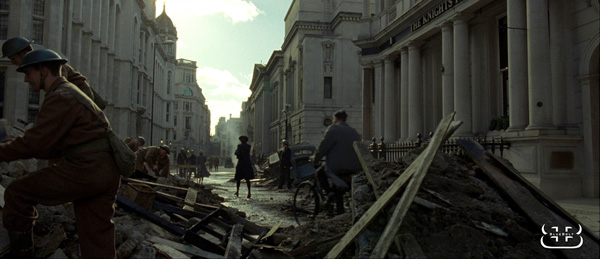BlueBolt worked as the sole visual effects vendor on ‘The Imitation Game’,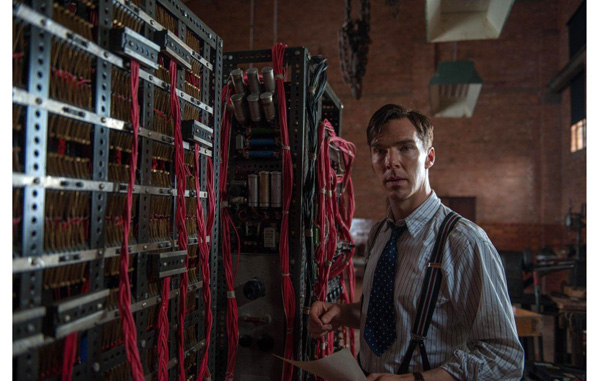
creating realistic, invisible VFX for shots depicting U-boats, aircraft, tanks
and streets during wartime in WWII.
BlueBolt Plays ‘The Imitation Game’ |
| BlueBoltcame on board as the sole visual effects vendor on Morten Tyldum’s film ‘The Imitation Game’ about Alan Turing’s code breaking project during WWII, starting on pre-production about eight weeks before the the shoot began. The team’sVFX Supervisor Stuart Bullensaid, “This was one of the tightest budgets we have worked with, but the script was so good that we could not pass up the opportunity to work on the film.” Their team has now been nominated for their work in the2015 VES Awards. |
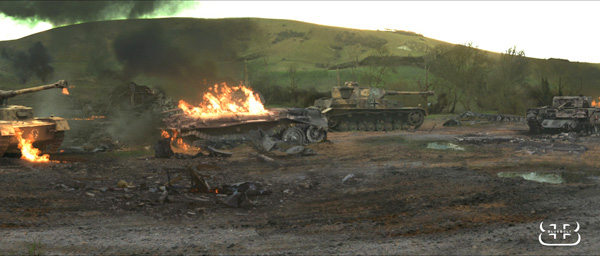 |
|
Air, Land and SeaWorld War II military vehicles – on land and in the air and sea - were key visual elements of this wartime story. Fortunately, the director made it clear from the start what he was looking for in the project, and had storyboards produced for underwater shots of German U-boats and various war ships at sea. “Morten also had a clear vision of the types of aircraft he wanted for the story,” Stuart said. “Because a reconnaissance plane was needed for the first aircraft seen in the film, with a little research we found that the Dornier airplane was ideal. We created a handful of variations of this plane in flight, some with stronger turbulence than others and each one was rendered from a different perspective. A side profile was the one that worked best for Morten. We used real photography for the skies, along with filmed elements of rain and smoke to give the feeling of atmosphere and speed.” |
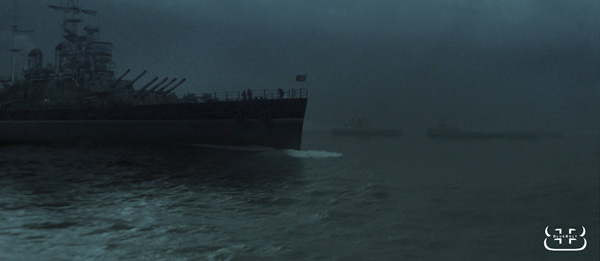 |
|
Overseas“For the lead ship, we photographed HMS Belfast, a British WWII Navy ship now permanently moored in London on the Thames. To achieve the correct angle, we shot it from the Shard, a 300m skyscraper in London, and then had a matte painting artist alter this image so it matched the ships that were accompanying the convoys in the Atlantic. For the other ships, we researched what the rest of a convoy in the Atlantic would look like in WWII,” said Stuart. “One of our compositors then animated the ships in the water along with their wakes, plus the added smoke coming from the ships’ funnels. At this point the shot was still static so the artist applied motion to the composite to give the impression of a first-person perspective. Rain was added next - this was a combination of rain elements shot against a black screen, and 2D rain created and generated within Nuke. |
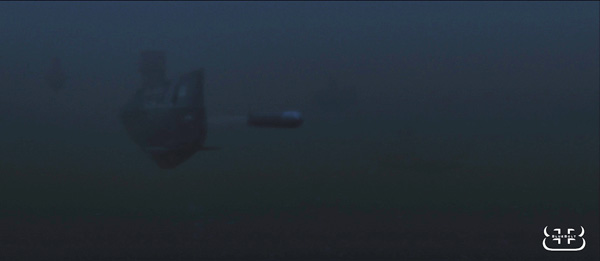 |
|
Another maritime shot shows three soldiers at sea in heavy, stormy weather on the deck of a convoy ship that was, again, based on the HMS Belfast and then manipulated by a DMP artist to resemble historically correct ships after carefully researching all ships recorded to have sailed in the Atlantic in convoys. They also needed to consider the size of the convoy and, therefore, the distance to surrounding ships. “We wanted the convoy to be large enough to give the shot some impact but not so big that it looked unrealistic, so it was really a numbers game that resulted in the distance to the next ship that you see,” Stuart said. “Our elements library supplied most of the elements required for these stormy weather shots, but as the shot developed in post we realised that the lighting on the soldiers was too bright for the scene that we wanted to create. So we were able to grade down the highlights to a certain point just before they become clipped. We included a brighter patch of light in the intro shot where the camera is looking up at the soldiers, that way we could explain the lighting direction that was coming from their helmets.”Stuart explained that BlueBolt always pushes to incorporate real elements into their effects work as far as possible, and these naval convoy shots were no exception. “Where you see ships breaking the surface of the water, we used filmed elements of ships doing just that,” he said. “We used our Canon 5D camera to film boats out on the Thames. These wakes, of course, would be too small for a battleship but once you layer up enough of them you can sell the scale of the larger ships.” |
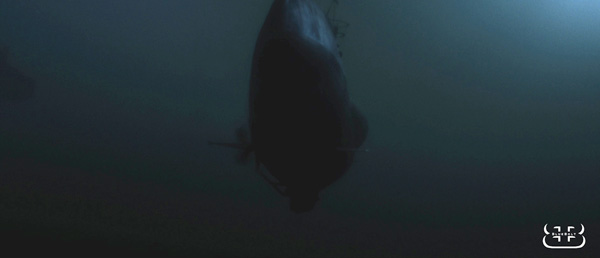 |
|
Going UnderThe transition from the ocean surface to the underwater encounter with the submarines involved still other, interesting challenges and approaches, including taking the camera down to look across the surface and then duck under it. They used a reduced camera crew to film the sea from a jetty. The camera was rigged on a crane giving full control on the timing of dipping the camera under the surface. This had to be timed to sync with a wave crashing over the lens to create a quick wipe from plate to VFX environment. The foreground ship is a 3D model with projected textures. Live action extras were shot on green screen and used to populate the deck. The remaining ships were digital matte paintings animated in 2D, and the team’s rain effects and sky replacement added to the ominous mood of the shot. |
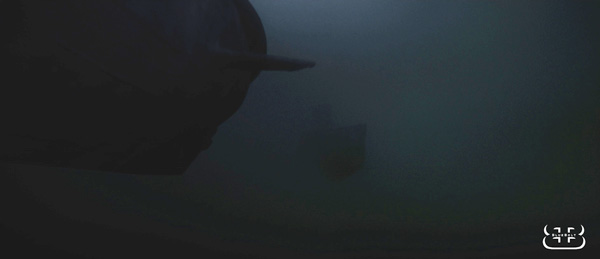 |
|
Submarine Animation“Animating submarines is actually a hard thing to sell. When travelling forwards, there is little motion in the fins, so the propellers may be the only moving part visible at a distance. In order to sell the motion, we played up the depth that the sub was travelling through and the parallax with the other U-boats. The propellers were rigged in a way that matched the real thing. Therefore, if it were turning left, the right propeller would rotate faster than the left. This effect is most visible in the shot where the sub is travelling away from camera.” Besides matchmoving a water plate, which is also very tricky, one of the other challenges was creating the lighting for all the submerged shots. Realistically, an observer would see very little in terms of depth from camera. Possibly one U-boat would be visible, but unfortunately that wasn’t going have the desired impact - they needed to reveal the full wolf pack of subs. “Taking a little artistic license, we tweaked the depth to where we can just make out the pack but still retain the oppressive, murky feel that Morten wanted,” said Stuart. “A combination of filmed elements of dust and Nuke-animated particles created the plankton and general floating particles that you expect in the sea. The bubbles were created in 3D and these were used for the entry of the camera into the water and for the torpedo release. |
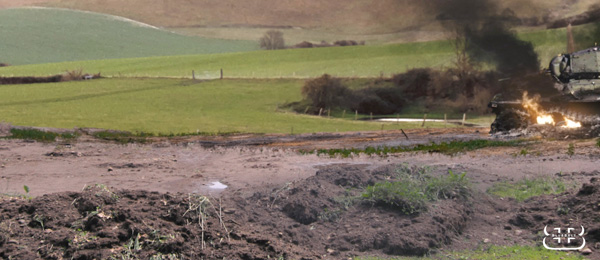 |
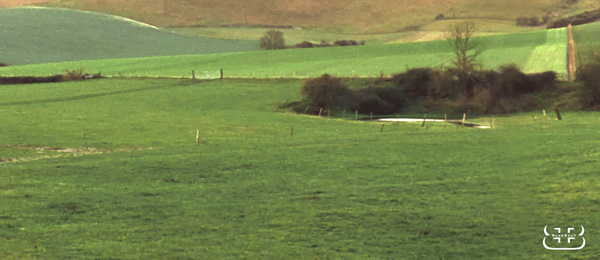 |
|
Postvis TanksBack on dry land, Bluebolt needed to transform a shot of green countryside to a battle scene featuring several tanks. However, as this shot was not imagined until post production, all the tanks had to be modelled, textured, rigged and animated from scratch. The 3D artists researched footage of such tanks in action and proceeded from there, despite the fact that that one of the tanks had to be shown slowly rumbling past very close to camera. “Ideally a practical prop would be best to achieve a shot like this,” said Stuart, “but filming had wrapped and post was underway when it was conceived. As we had no live action to begin with, we started with previs of the tank. Once we had the composition looking right, the key to making this work was the rigging and animation of the tank. Each individual tank track needed to move independently with a weight heavy enough to sell the scale of the tank.” |
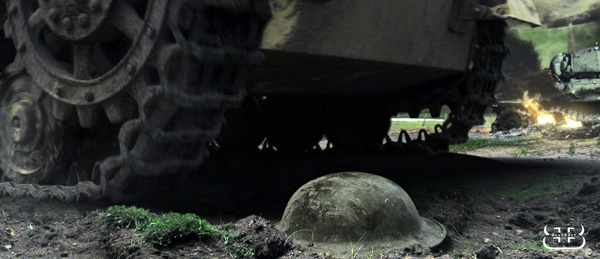 |
|
The CG mud was used especially for the interaction with a lone helmet, seen sinking into the dirt as a tank rolls over it. Stuart said, “The helmet idea came from one of our discussions with the director. It was one of those moments where the phrase ‘wouldn’t it be great if...’ was mentioned. Previs once again gave us the timing of the tank we needed to force the helmet down. Our 3D team animated the helmet being crushed and forced into the ground, and CG mud around the helmet helped with its integration into the rest of the composite.” Bomb SiteThe movie’s bombed out street scenes took more research, and were created from plates shot in central London near Chancery Lane. The set dressing was added at street level, excluding the bombed out buildings and any destruction above head height, all of which was added in post. “A central London location like this carries many restrictions about what the set dressers could touch,” Stuart explained. “Therefore, dirtying up the buildings at street level had to be added in post as well. |
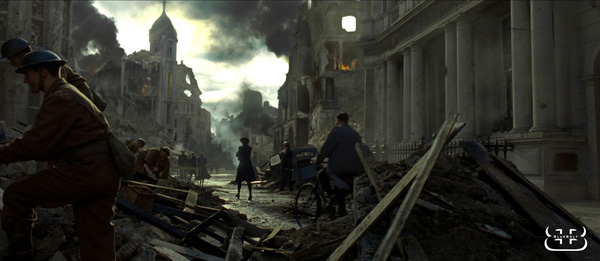 |
|
|
|
"Examples of this would be a man sifting through rubble in a hollowed out building, rubble still breaking away from weakened walls, and the finer details of office furniture still in their rooms but clearly visible, as the walls no longer exist. Virtually all of the people were included in the main plate. Just a couple of extra actors were shot separately against blue screen and added on top of hollowed out buildings, searching through the rubble. “We had a couple of shots that required sky replacements but we needed to keep close to the exposure and general grade of the original sky in order for it to sit in correctly. All too often sky replacements are noticeable and that mostly comes down to the changes being too great. Subtlety was the key here.” Words: Adriene HurstImages: Courtesy of Roadshow Films |


